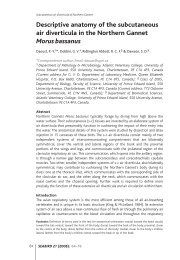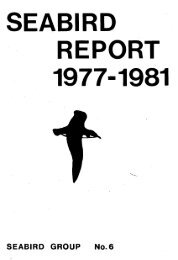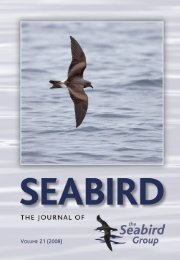You also want an ePaper? Increase the reach of your titles
YUMPU automatically turns print PDFs into web optimized ePapers that Google loves.
2001 Flight altitudes of coastal birds 209<br />
Table 2. <strong>The</strong> numbers of coastal migrants passing Wangerooge in autumn 1999,<br />
grouped according to wind direction and flight altitude. χ² = significance of<br />
the 2*3 contingency tables for differences between headwinds and tail winds.<br />
p < 0.001.<br />
Tabel 2. Aantal trekvogels dat Wangeroog najaar 1999 passeerde, gegroepeerd naar<br />
windrichting en vlieghoogte. p < 0.001.<br />
Headwind Tailwind<br />
low medium high low medium high χ²<br />
Red-throated Diver 113 21 2 38 30 43 74.4<br />
Shelduck 218 70 17 107 221 380 349.9<br />
Common Eider 2442 1428 371 2998 3850 3316 1305.9<br />
Common Scoter 3286 711 33 1022 1389 308 1429.8<br />
Sandwich Tern 179 560 40 0 63 117 392.1<br />
Comm/Arctic Tern 5 117 26 0 33 90 85.8<br />
flew low over the water during headwinds, whereas the medium level was used<br />
most often during tail winds (51%; Fig. 3).<br />
Most Sandwich Terns Sterna sandvicensis flying into the wind clearly<br />
preferred the medium level (72%) and a further 23% selected the low level (Fig.<br />
3). In tail winds the high level was most frequently used (65%); 35% flew at<br />
medium height, and there were no records of low-flying migrating Sandwich<br />
Terns. 79% of Common/Arctic Terns S. hirundo/paradisaea migrated in<br />
headwinds at medium levels and another 18% flew high (Fig. 3). Headwinds<br />
saw the bulk (73%) of the birds in the high flight path, whereas only 23% were<br />
to be found at medium height.<br />
Even within a single observation day it became evident that flight<br />
altitude was influenced by the direction of the wind. During the autumn<br />
migration period, Common Eiders off Wangerooge regularly moved in both<br />
easterly and westerly directions (see also Camphuysen & van Dijk 1983,<br />
Platteeuw et al. 1994). On days during which migration took place in both<br />
directions, one of the routes – eastward or westward – had headwinds. On nine<br />
headwind days (only days with more than 1,000 individuals were considered),<br />
Common Eiders migrated for the most part low in a westerly direction.<br />
Conversely, birds moving east on those days mostly had a medium or high flight<br />
altitude (Fig. 4). In same-day comparisons, they always moved one or two levels<br />
higher up. On nine tail wind days, however, the mass of the birds migrated<br />
medium or high levels in a westerly direction. <strong>The</strong> birds moving east for the<br />
most part flew low over the water (Fig. 4).








